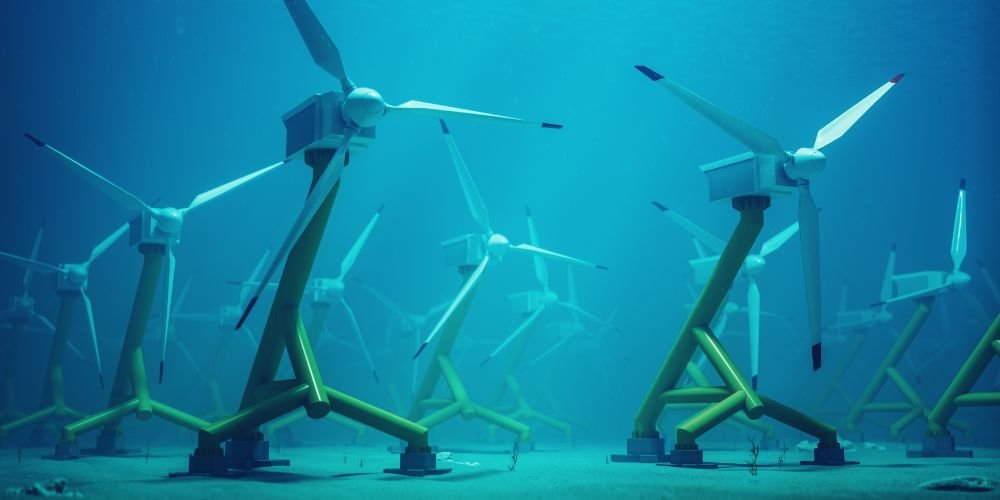In the quest for clean and renewable energy sources, tidal energy has emerged as a promising solution that harnesses the power of ocean tides to generate electricity. This article explores the principles behind tidal energy, its environmental benefits, current technological advancements, and the transformative potential it holds in contributing to a more sustainable energy landscape.
Understanding Tidal Energy
Tidal energy is a form of hydropower that captures the kinetic energy generated by the rise and fall of tides in the Earth’s oceans. This cyclical movement of water, driven by the moon’s and the sun’s gravitational forces, presents a reliable and predictable renewable energy source.
Types of Tidal Energy Systems
Tidal energy systems can be categorized into two main types: tidal stream and range systems.
- Tidal Stream Systems: These systems harness the kinetic energy of moving water, similar to underwater currents or river flows. Turbines, often resembling underwater wind turbines, capture the energy from the flowing tides and convert it into electricity.
- Tidal Range Systems: Tidal range systems, also known as tidal barrages, utilize the potential energy created by the difference in height between high and low tides. Barrages are constructed across estuaries or tidal basins, and as the tide rises and falls, the potential energy is converted into electricity through turbines.
Environmental Benefits of Tidal Energy
Tidal energy offers several environmental benefits, positioning it as a sustainable and eco-friendly alternative to traditional fossil fuels.
Low Carbon Footprint
Tidal energy systems produce electricity without directly emitting greenhouse gases. This low carbon footprint contributes to mitigating climate change and reducing the environmental impact of traditional fossil fuel-based power generation.
Predictable and Reliable
Unlike intermittent renewable energy sources, such as solar and wind, tidal energy is highly predictable and reliable. The regular ebb and flow of tides provide a consistent and dependable energy source, enhancing grid stability and energy planning.
Minimal Visual Impact
Tidal energy systems, particularly tidal stream systems located underwater, have minimal visual impact on coastal landscapes. This characteristic makes tidal energy a more aesthetically pleasing option than other renewable energy technologies.
Current Technological Advancements
Advancements in tidal energy technology are paving the way for increased efficiency, cost-effectiveness, and broader deployment of tidal energy systems.
Tidal Turbine Innovation
Ongoing research and development focus on improving the design and efficiency of tidal turbines. Innovations include the development of more robust and efficient turbine blades, materials, and control systems to optimize energy capture and reduce maintenance requirements.
Subsea Energy Storage
Researchers are exploring subsea energy storage solutions to address the intermittent nature of tidal energy production. These systems store excess energy generated during peak tidal periods and release it during low tide or periods of high energy demand, contributing to grid stability.
Environmental Impact Assessment
As the industry grows, there is an increasing emphasis on conducting thorough environmental impact assessments (EIAs) to ensure that tidal energy projects have minimal ecological consequences. It includes studying the potential effects on marine life, sediment transport, and coastal ecosystems.
Challenges and Considerations
While tidal energy holds great promise, some challenges and considerations must be addressed for widespread adoption.
High Initial Costs
The construction of tidal energy infrastructure, such as tidal barrages or underwater turbines, involves high initial capital costs. However, technological advancements and increased deployment are expected to drive down costs over time.
Environmental Impact and Marine Ecosystems
Tidal energy projects must carefully consider their potential impact on marine ecosystems. Measures to prevent harm to marine life, habitat disruption, and sediment transport need to be implemented through comprehensive environmental monitoring and mitigation strategies.
Site-Specific Nature
Tidal energy’s suitability varies by location, depending on the amplitude of tides and the geography of the coastline. Identifying suitable sites with optimal tidal conditions is crucial for the success of tidal energy projects.
Transformative Potential and Future Outlook
Tidal energy holds transformative potential to contribute to a more sustainable and diversified energy mix.
Growing Industry Interest
As technological advancements continue and governments seek cleaner energy alternatives, there is a growing interest in tidal energy within the energy industry. Increased investments, research, and collaborative efforts are driving the expansion of the tidal energy sector.
Integration with Other Renewables
Tidal energy has the potential to complement other renewable energy sources, creating hybrid systems that enhance overall energy reliability and sustainability. Integrated approaches that combine tidal energy with solar, wind, and energy storage technologies could offer a comprehensive solution for diverse energy needs.
Global Collaboration for Tidal Energy
International collaboration is crucial for advancing tidal energy technology and sharing best practices. Collaborative research efforts, knowledge exchange, and joint projects can accelerate developing and deploying tidal energy solutions globally.
Conclusion
Tidal energy stands at the forefront of the renewable energy revolution, offering a predictable, reliable, and environmentally friendly source of electricity. While facing challenges and considerations, ongoing technological advancements and a growing awareness of the need for sustainable energy sources position tidal energy as a key player in transitioning to a cleaner and more resilient energy future. As the industry matures and global efforts intensify, tidal energy is poised to contribute significantly to the world’s sustainable energy portfolio.





